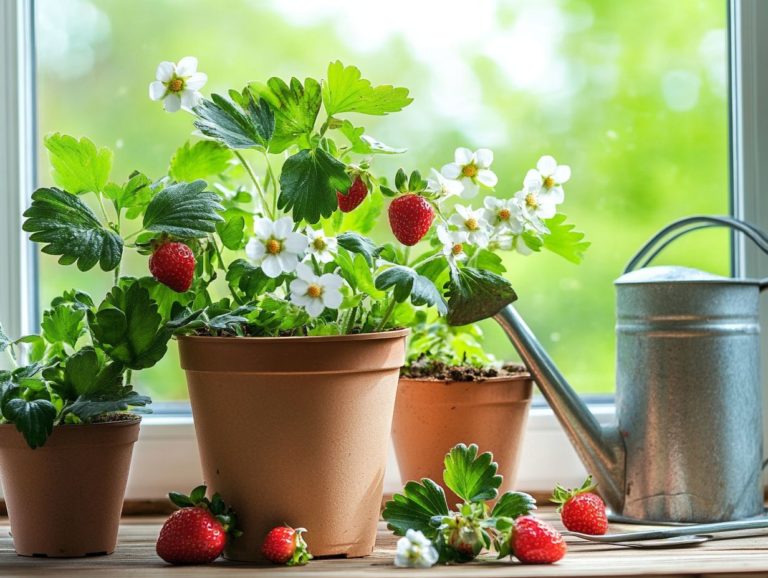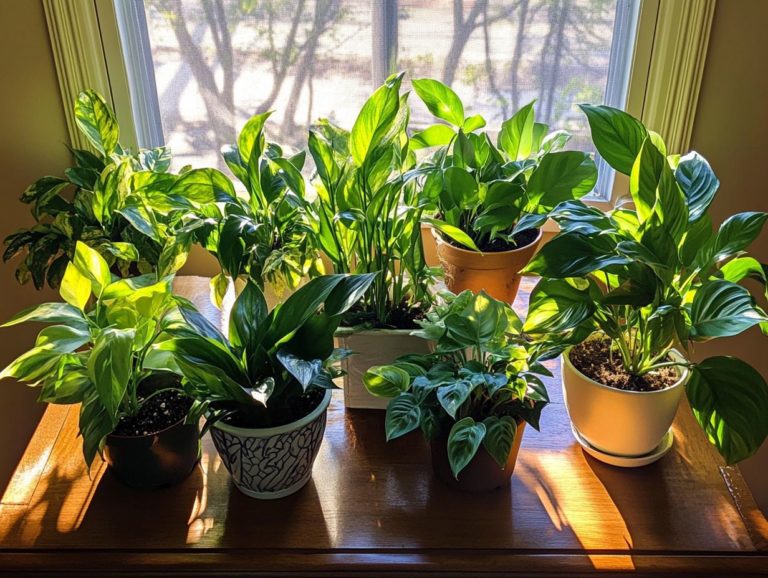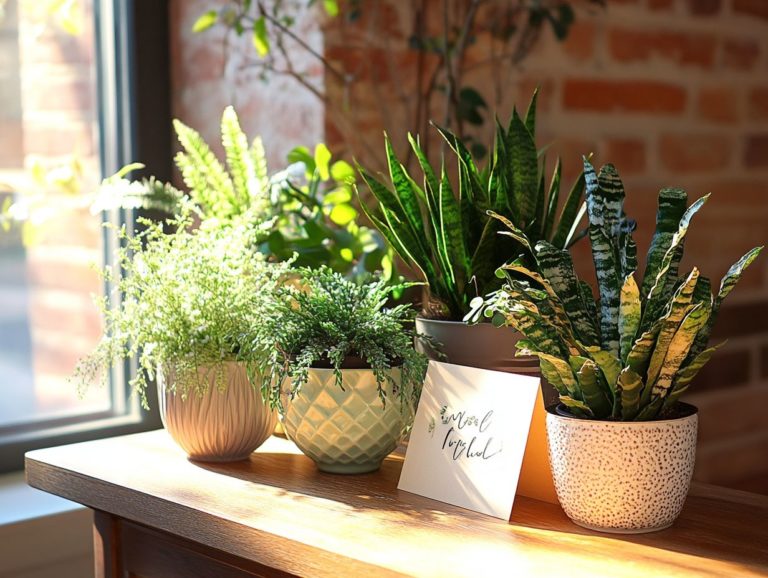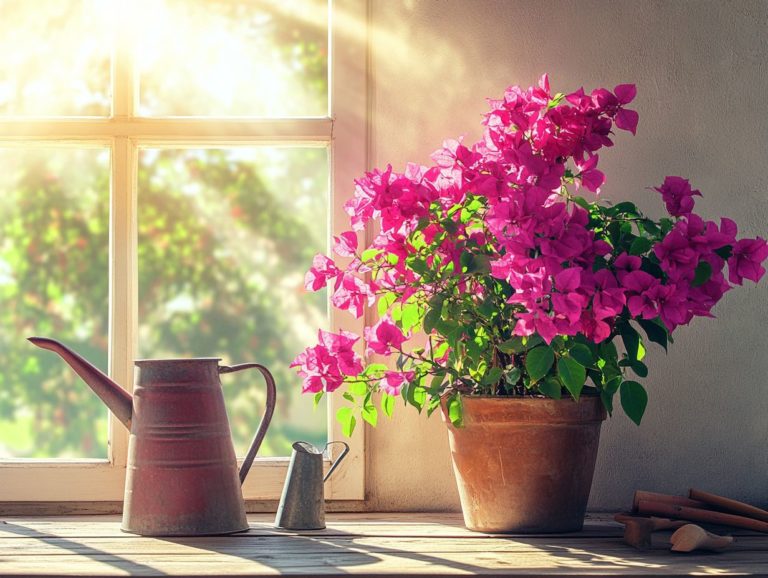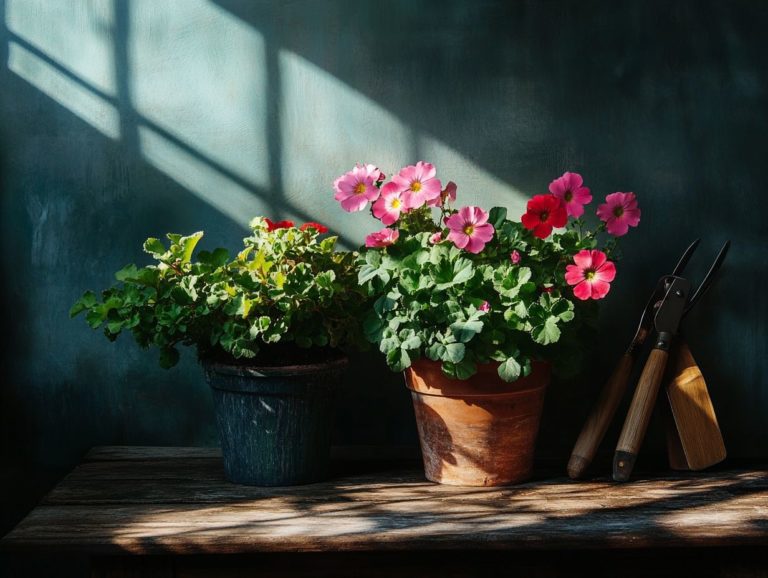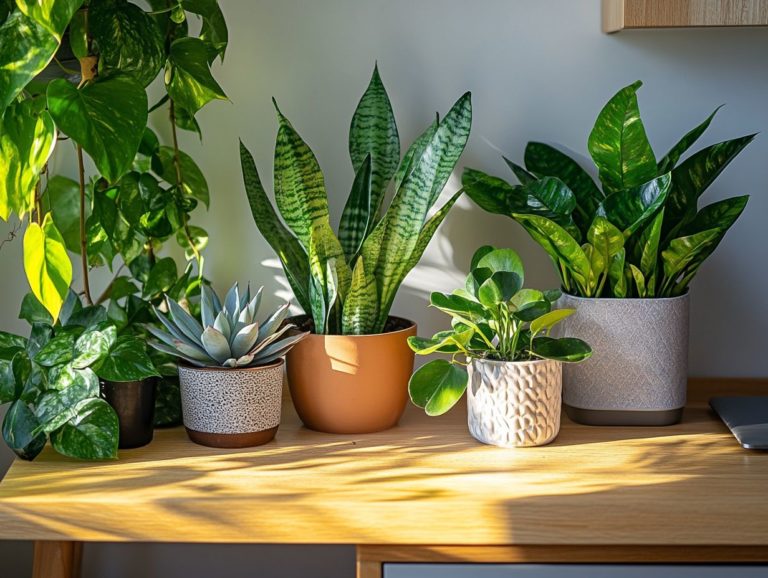The Best Indoor Ferns for Beginners
If you re aiming to infuse your home with a touch of greenery, indoor ferns are an exceptional choice. These lush, low-maintenance plants not only elevate your decor but also enhance the air quality in your space.
Discover some of the best ferns for beginners, from the elegant Boston Fern to the intriguing Staghorn Fern, both popular houseplants known for their beauty and ease of care.
You ll find essential tips for caring for these plants, a rundown of common pitfalls to avoid, and creative ideas for incorporating ferns into your living environment.
Whether you re a seasoned plant parent or just embarking on your botanical journey, there s a fern perfectly suited for you!
Contents
- Key Takeaways:
- 1. Boston Fern
- 2. Maidenhair Fern
- 3. Bird’s Nest Fern
- 4. Asparagus Fern
- 5. Staghorn Fern
- 6. Button Fern
- 7. Rabbit’s Foot Fern
- 8. Holly Fern (Cyrtomium falcatum)
- 9. Japanese Painted Fern
- 10. Silver Lace Fern
- 11. Australian Tree Fern
- 12. Sensitive Fern
- 13. Southern Maidenhair Fern
- 14. Cretan Brake Fern
- 15. Lemon Button Fern
- What Are the Benefits of Having Indoor Ferns?
- Frequently Asked Questions
Key Takeaways:

- Boston Fern, Maidenhair Fern, and Bird’s Nest Fern are great choices for beginners. They are low-maintenance and can adapt to various environments, perfect for indoor plant care.
- When choosing an indoor fern, consider light and humidity needs, size, and toxicity to pets.
- Indoor ferns require consistent moisture, indirect sunlight, and occasional plant food. Avoid overwatering and direct sunlight.
1. Boston Fern
The Boston Fern, scientifically known as Nephrolepis exaltata, stands out as a favored choice for indoor gardening enthusiasts. Its lush greenery and remarkable air-purifying abilities make it an elegant addition to your home.
This fern thrives in humid environments and indirect light. To see the Boston fern flourish, focus on soil drainage and humidity levels.
Characterized by its feathery, arching fronds, the Boston fern prefers a warm climate, typically between 60-75 F. It thrives in high humidity, ideally around 70-90%. A pebble tray filled with water or regular misting can work wonders.
It craves bright, indirect light but should be shielded from direct sunlight to avoid unsightly leaf burn. While these ferns enhance your indoor ambiance, they can encounter hurdles like browning leaves or pesky spider mites.
Regularly feed your Boston fern with watered-down plant food during the growing season. Engage in periodic pruning to ensure it remains healthy and thriving, amplifying its role as a natural air purifier in your space.
2. Maidenhair Fern
The Maidenhair Fern, scientifically known as Adiantum raddianum, is a delicate and captivating houseplant that elevates the elegance of any indoor space. While it requires a bit of specialized care, it becomes relatively low-maintenance once you grasp its needs.
Its lush, fan-shaped leaves create a graceful silhouette, making it a favored choice among plant aficionados. This fern flourishes in indirect light and thrives in humidity.
For optimal growth, use well-draining soil that retains moisture without becoming overly saturated. A blend of potting soil and peat yields fantastic results. Watch the leaves for any yellowing or wilting, as these can signal early signs of distress.
3. Bird’s Nest Fern
The Bird’s Nest Fern, known scientifically as *Asplenium nidus*, is a stunning choice for anyone looking to enrich their indoor garden with vibrant greenery. Its unique rosette shape, reminiscent of a bird’s nest, paired with glossy, wavy fronds, creates a captivating focal point in any room.
This fern thrives in indirect light and requires a humid environment, making proper care essential for its growth. To ensure it flourishes, consider planting the Bird’s Nest Fern in a well-draining potting mix a type of soil that allows water to flow out easily, preventing root rot.
Consistency is key when it comes to watering; keep the soil lightly moist and mist the fronds regularly to uphold humidity levels. This fern thrives in temperatures between 60 F and 75 F, creating an ideal indoor habitat.
Incorporating this striking plant into your home decor is effortless simply place it in a chic pot on shelves, in hanging baskets, or on tabletops. Its vibrant greenery will not only stand out but also enhance the overall aesthetic of your living space, transforming it into a serene oasis.
4. Asparagus Fern
The Asparagus fern, or *Asparagus densiflorus*, is a delightful option for your indoor gardening endeavors. While it may not be a true fern, it offers a unique texture and low maintenance that appeals to many.
Its feathery, soft foliage brings a refreshing touch to your space and thrives in various light conditions, making it a versatile addition to any decor style. You’ll appreciate how it flourishes even with less frequent watering and care.
With its graceful, arching stems, the Asparagus fern can effortlessly blend into both traditional and modern interiors, whether as a striking centerpiece or a subtle accent in a cozy nook.
To promote robust growth, maintain a well-draining potting mix and place it in indirect light for optimal results. Regularly pruning yellowing leaves and gently dusting the foliage will not only boost its health but also enhance its visual appeal.
Pairing this vibrant plant with earthy ceramic pots or minimalist planters will further showcase its beauty, perfectly complementing a range of decor themes.
5. Staghorn Fern
The Staghorn fern, part of the intriguing genus *Platycerium*, is an exceptional choice for your indoor gardening endeavors, boasting unique antler-like fronds that truly stand out. This eye-catching plant is a showstopper in any home, whether mounted on a wall or showcased in a hanging basket.
With the right humidity and care, the Staghorn fern can flourish in a variety of indoor environments, adding a touch of natural beauty to your space. To create a thriving environment for your Staghorn fern, you ll need to pay attention to its specific care requirements.
These ferns thrive in indirect light, perfectly mimicking their natural habitat beneath trees. They enjoy a gentle misting, as they absorb moisture through their fronds. Just be cautious overwatering can lead to root rot, which is something you definitely want to avoid.
Regarding mounting options, think outside the box. Whether you choose wooden plaques or coconut coir, there s plenty of room for creativity in how you display this fascinating plant. With the right care, the Staghorn fern not only elevates your aesthetic appeal but also enhances air quality, making it a truly rewarding addition to your home.
Choose plants that suit your lifestyle and enjoy the benefits they bring to your space!
6. Button Fern
Imagine transforming your space with the stunning Button Fern! Known scientifically as Pellaea rotundifolia, this delightful indoor plant effortlessly brings a touch of greenery into your home.
Its uniquely rounded leaflets offer a visually appealing texture, earning it a special place in the hearts of plant enthusiasts. Perfect for those who appreciate easy indoor plant care, this fern thrives with proper soil drainage and indirect light.
It s a low-maintenance option that fits seamlessly into various home environments. Ideal for small spaces, the Button Fern can gracefully occupy shelves, desks, or even windowsills without overwhelming your decor.
For soil, a well-draining mix is crucial; combining potting soil with perlite or coarse sand works wonders to keep waterlogging at bay. Aim to keep the soil slightly moist avoid soaking it, as this fern loves humidity!
With its lush green foliage and compact size, the Button Fern not only enhances your aesthetic but also improves air quality, making it an excellent choice for anyone looking to elevate their indoor garden.
7. Rabbit’s Foot Fern
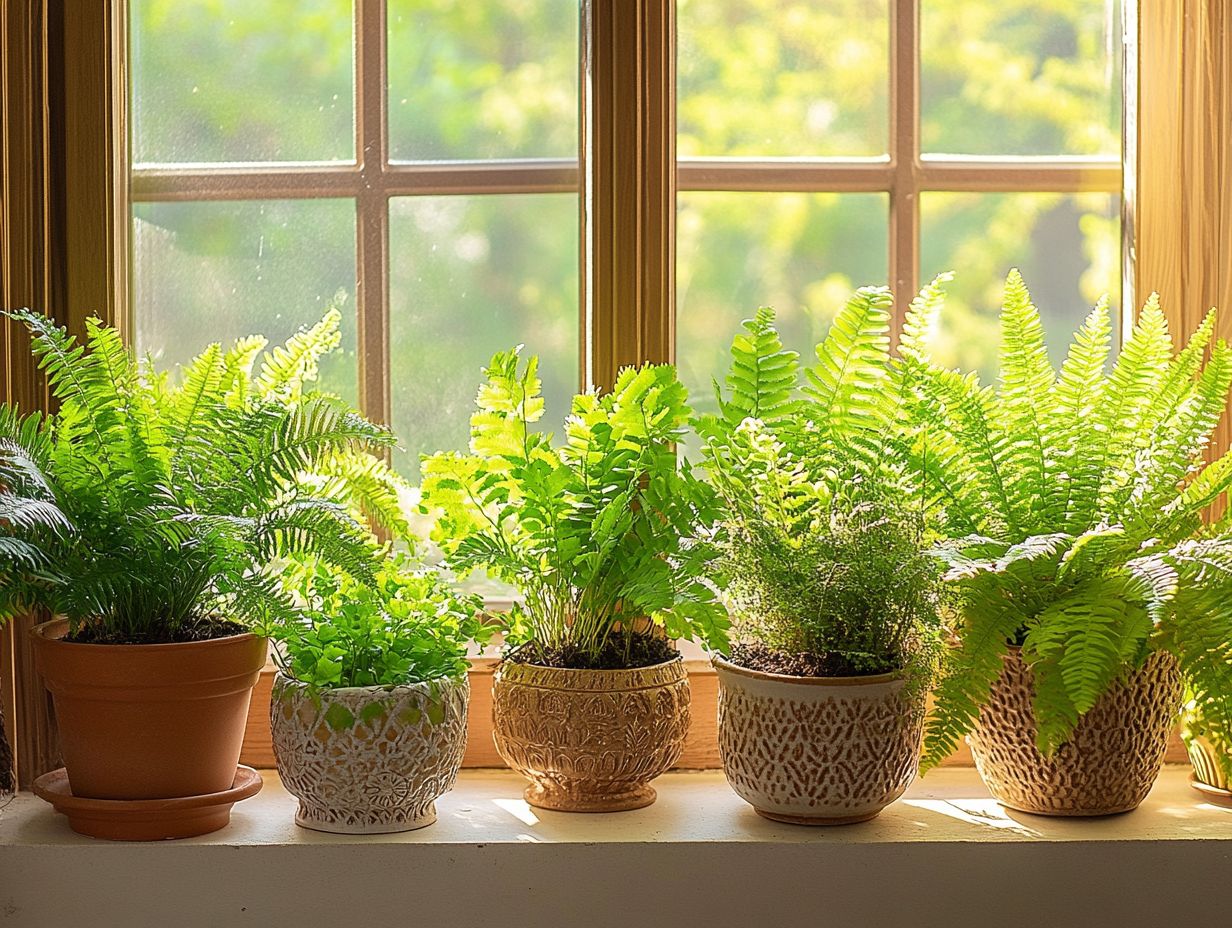
The Rabbit’s Foot Fern, known scientifically as Phlebodium aureum, stands out with its charming root-like structures that resemble rabbit feet, adding a delightful twist to your collection of houseplants.
This fern is wonderfully low-maintenance, thriving in humid environments and indirect light. It’s perfect for various indoor spaces, appealing to both beginners and experienced plant enthusiasts alike. If you’re looking for more options, check out the top indoor plants for beginners and their soil needs.
To support its growth, keep humidity levels around 50-70%. A steamy bathroom or a tray filled with water and pebbles can work wonders. This fern prefers bright, indirect sunlight, so keep it away from harsh direct rays that could scorch its beautiful leaves.
Incorporating this vibrant fern into your home will instantly brighten your space and create a calming atmosphere, making it an excellent choice for crafting a serene living space filled with lush greenery.
8. Holly Fern (Cyrtomium falcatum)
The Holly Fern is your go-to choice for a striking indoor plant that combines resilience with beauty. With its glossy, dark green fronds that evoke the charm of holly leaves, this fern elevates any space.
It thrives easily in a range of indoor settings, provided there’s adequate humidity and indirect light perfect for those eager to infuse elegance into their homes.
To keep your Holly Fern in top shape, aim for a moderate temperature and give it a good misting to mimic its natural humid environment. This plant gracefully complements various decor styles, acting as a stunning focal point or a subtle enhancement to your existing furnishings.
For optimal health and growth, ensure that the pot has excellent drainage and be careful not to overwater, as that could spell disaster with root rot. During the growing season, incorporating organic fertilizers can work wonders, enhancing its lush appearance and ensuring your Holly Fern remains a vibrant presence in any room.
9. Japanese Painted Fern
The Japanese Painted Fern, or Athyrium niponicum, is a true gem, celebrated for its striking silver and purple foliage. It s an exceptional choice for anyone passionate about indoor gardening.
This unique fern flourishes in shady spots with well-draining soil and moderate humidity, adding a touch of sophistication to your home decor. Its stunning leaves create a captivating contrast with other houseplants, elevating your indoor aesthetic.
Incorporating this magnificent fern into your interior design infuses a sense of tranquility and elegance, transforming any corner into a lush retreat. Think about placing it in decorative pots or hanging planters that allow the delicate fronds to cascade gracefully.
The Japanese Painted Fern thrives on consistent moisture, so regular misting and ensuring the soil doesn t dry out are essential care steps. For optimal growth, using a balanced fertilizer every few weeks will invigorate its vibrant colors, while relocating it to a slightly cooler environment during winter will contribute to its longevity and beauty.
10. Silver Lace Fern
The Silver Lace Fern, known scientifically as Pteris cretica, is a true gem in the world of indoor plants. People admire its delicate fronds featuring a lacy, silver leaves that effortlessly elevates any space.
It thrives in bright, indirect light and relishes a humid environment. This fern is a favorite among gardeners who love its stunning look and easy care!
To keep your fern flourishing, ensure the soil maintains consistent moisture without overwatering. It prefers well-draining soil, so regular misting can be a game-changer, especially in drier indoor air.
Consider placing this beauty in a stylish pot to transform any corner of your home. It beautifies spaces like living rooms or offices while it cleans the air.
Don t forget to routinely prune any yellowing fronds. This simple practice will help your fern remain vibrant and healthy. Bring this beauty home today!
11. Australian Tree Fern
The Australian Tree Fern, or Cyathea australis, brings the beauty of the outdoors inside. With its towering presence and exquisite fronds, this fern thrives best in indirect light.
It appreciates ample humidity, making it the perfect choice for larger spaces. When cared for properly, it becomes an impressive focal point in your indoor gardening collection.
To craft the ideal environment, maintain a humidity level of at least 50%. You can achieve this by misting the plant regularly or placing a humidifier nearby.
While it enjoys bright, filtered light, direct sunlight can scorch its delicate leaves. Finding that perfect balance is essential.
This fern adapts beautifully to various settings, whether it graces your living room or enhances the ambiance of your bathroom. When nurtured in optimal conditions, it can grow remarkably tall, adding a touch of dramatic flair to any indoor space. Bring home this stunning plant today!
12. Sensitive Fern
The Sensitive Fern, or Onoclea sensibilis, stands out among ferns with its remarkable ability to wilt at the slightest touch, truly embodying its sensitive nature. This hardy fern thrives in shaded, humid environments, making it a captivating addition to your indoor gardening setup.
To care for this delicate beauty effectively, maintain consistent moisture. It prefers well-draining soil that retains humidity without becoming waterlogged.
Gentle misting simulates its natural, damp habitat, while positioning it away from direct sunlight ensures its delicate leaves remain pristine. During the growing season, a diluted, balanced fertilizer every few weeks can support its vibrant growth.
Notably, the Sensitive Fern’s resilience against certain pests allows it to flourish with minimal chemical interventions. This makes it an eco-friendly option for anyone looking to embrace nature within their home. Get this fern to enhance your space today!
13. Southern Maidenhair Fern
The Southern Maidenhair Fern, or Adiantum capillus-veneris, is a delicate and graceful plant that can elevate your indoor spaces. With its feathery, green fronds, this fern thrives in humid environments with indirect light.
To ensure it flourishes, maintain optimal humidity levels, ideally around 50-70%. You can easily achieve this with a humidifier or a pebble tray filled with water.
This fern prefers bright, indirect sunlight; direct rays could scorch its tender leaves. Be careful to avoid that.
Watering is crucial keeping the soil slightly moist is essential, but avoid over-saturating it, as that can lead to root rot. You can incorporate this lovely plant into your home by placing it on a stylish shelf, in a hanging planter, or as part of a terrarium.
This not only showcases its unique form and vibrant color but also creates a serene, botanical ambiance that enhances your living space. Bring this elegant fern home today!
14. Cretan Brake Fern
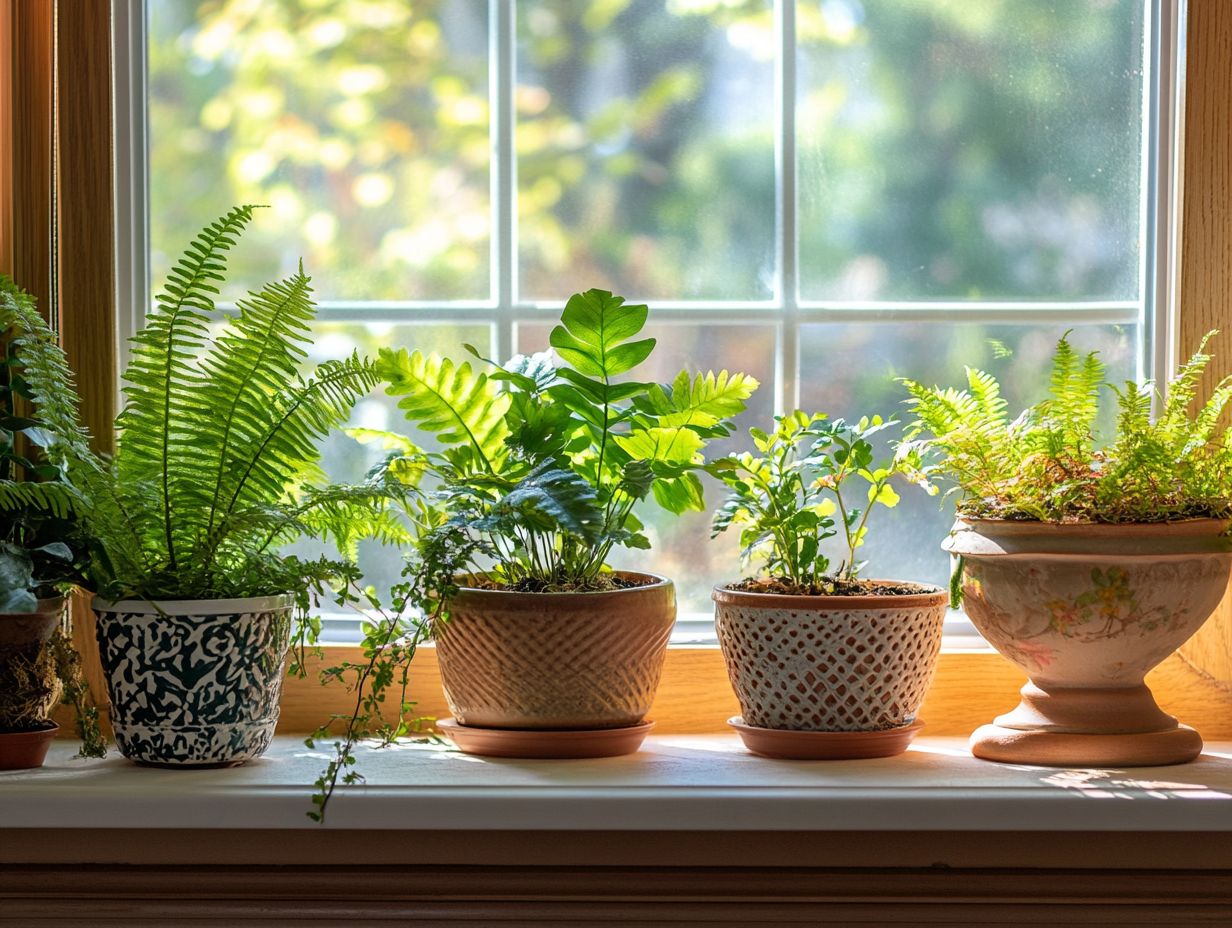
The Cretan Brake Fern, or Pteris cretica, makes a delightful addition to indoor spaces. Its graceful, arching fronds provide a soft, lush charm.
This fern thrives in indirect light and well-draining soil, making it an ideal option for your indoor gardening pursuits, especially if you prefer top indoor plants for beginners that need little care. Its remarkable adaptability to varying humidity levels only enhances its appeal as a houseplant.
To promote the best growth, maintain a consistent watering routine. Allow the top inch of soil to dry out between sessions. Its striking green foliage, often adorned with unique patterns, can significantly elevate the aesthetic of your indoor garden, providing vibrant contrast against other plants or decorative pots.
The Cretan Brake Fern flourishes in environments with a touch of humidity. It’s an excellent choice for kitchens or bathrooms, where moisture levels are naturally higher. For those new to plant care, exploring the best indoor plants for beginners can provide more options. This versatile plant not only purifies the air but also introduces an element of tranquility, seamlessly complementing both modern and traditional interior designs.
15. Lemon Button Fern
The Lemon Button Fern, a delightful variant of Nephrolepis exaltata, is truly a treasure. You ll love how its small, round leaflets evoke the charming appearance of buttons.
This lovely plant flourishes in humid conditions and indirect light, making it an excellent choice for your indoor gardening collection. With attentive care, the Lemon Button Fern can thrive beautifully, adding a refreshing burst of greenery to your living space.
To keep this fern in top shape, ensure the soil remains consistently moist think damp, not soggy. Opting for a well-draining potting mix will do wonders. Regular misting can replicate its beloved humid environment, especially during those drier months.
When it comes to light, positioning it near a window with filtered sunlight is ideal; direct sunlight can scorch its delicate leaves. With its unique texture and appealing color, the Lemon Button Fern can be a creative focal point in your home decor. Consider placing it in decorative pots or hanging planters to elevate its aesthetic appeal while enjoying the vibrant greenery it brings.
What Are the Benefits of Having Indoor Ferns?
Having indoor ferns not only elevates the aesthetic charm of your home but also brings a plethora of benefits, including air purification and enhanced humidity levels both essential for your overall well-being. Ferns like the Boston fern and Maidenhair fern are renowned for filtering pollutants and improving indoor air quality, making them invaluable allies in your indoor plant care routine.
The lush greenery they provide infuses life into your spaces, fostering a healthier living environment. These plants thrive in moist conditions, effectively regulating humidity to counteract the dryness often prevalent in heated indoor environments.
Beyond their physical advantages, indoor ferns have the remarkable ability to uplift your mood and alleviate stress, thanks to their vibrant foliage and calming presence. Species such as the Bird’s Nest fern and Ostrich fern not only act as natural air purifiers but also contribute to a tranquil atmosphere. For those interested in more options, check out the best indoor foliage plants for low light, making them perfect for spaces dedicated to relaxation or focus.
By incorporating a diverse array of ferns, you can cultivate an inviting ambiance that nurtures a balanced ecosystem, benefiting both your mind and body. For those new to indoor gardening, consider exploring the top 10 easy indoor plants for beginners to start your indoor fern collection today and transform your home into a lush oasis!
What Are the Key Factors to Consider When Choosing an Indoor Fern?
When selecting an indoor fern, several key factors come into play: humidity levels, light conditions, and soil drainage. These elements are vital for the health of your plant. Understanding these needs can influence your success in indoor gardening and enhance the aesthetic of your home.
Popular choices like the Boston fern and Staghorn fern have specific requirements. This makes informed decisions essential for your indoor plant care routine. Taking a good look at your indoor environment helps you choose the right fern species. It also ensures these delicate plants flourish in their designated spots.
Some ferns thrive in bright, indirect light, while others are perfectly content in lower light levels. Assess the natural light your room receives throughout the day.
To maintain the humidity that ferns often crave, consider using a humidifier, misting the leaves, or placing trays of water nearby. Align the fern’s needs with your indoor conditions to boost your chances of creating a lush, green sanctuary that beautifully complements your living space.
How Can One Care for Indoor Ferns?
Caring for indoor ferns is an exciting journey! Understanding their distinctive needs regarding humidity, watering, and light exposure is key to ensuring they flourish in your home. Check the soil moisture regularly and provide the right amount of indirect light for successful indoor plant care.
With attention to these elements, you can enjoy healthy, vibrant ferns like the Rabbit’s Foot Fern or the Maidenhair Fern.
To maintain their lush appearance, aim for consistent watering just enough to keep the soil moist but never waterlogged. Ferns thrive in higher humidity, so consider misting them or placing a humidifier nearby. Pruning any dead or yellowing fronds stimulates growth and improves air circulation.
During the growing season, a balanced fertilizer provides the essential nutrients they crave. If you notice browning tips or wilting leaves, it may suggest insufficient watering or low humidity. Yellowing leaves could indicate overwatering. Addressing these common issues swiftly can keep your delicate plants thriving.
What Are the Common Mistakes to Avoid When Growing Indoor Ferns?
Wondering how to keep your ferns thriving? Many indoor gardeners stumble into common pitfalls that can hinder their growth and overall vitality. Over-watering, insufficient humidity, and poor lighting conditions are frequent missteps that lead to stress among fern species.
By recognizing these errors, you can elevate your plant care routine and ensure that your indoor ferns, like the Boston fern or the Silver Lace fern, thrive. If you’re just starting out, consider looking into what is the best indoor plant for beginners to find options that are easier to care for.
To avoid over-watering, check the top inch of the soil for dryness before reaching for your watering can. Ferns are particularly sensitive to soggy roots, which occur when the soil is too wet. For humidity, think about placing a small humidifier in the room or using pebble trays filled with water to create a more favorable environment.
Regarding lighting, aim for indirect light. Position your ferns near bright, filtered light sources to keep them content, while avoiding harsh direct sunlight that can scorch their delicate leaves. Tailoring your care to each species unique needs will help you create a vibrant indoor garden that delights the senses.
How Can One Incorporate Indoor Ferns into Their Home Decor?
Incorporating indoor ferns into your home decor can transform your space into a refreshing oasis, seamlessly blending nature with your interior design. Consider species like the Japanese Painted Fern and the Boston Fern; these plants can elevate the aesthetic appeal of any room, infusing your space with vibrant greenery.
By placing these plants in well-lit areas or showcasing them in unique planters, you not only enhance your decor but also reap the rewards of indoor gardening. Imagine grouping several ferns of varying heights in decorative pots for a visually captivating display!
Hanging planters provide a great option; they allow the lush fronds to cascade down, filling vertical spaces without consuming valuable surface area. When selecting ferns, consider looking into the best indoor plants for beginners and keep your overall decor and lighting conditions in mind.
For example, the delicate Maidenhair Fern thrives in indirect sunlight and complements minimalist decor beautifully, while more resilient varieties can brighten up those darker corners. By thoughtfully arranging these plants, you can create a balanced mix of plants that reflects your unique style.
Frequently Asked Questions
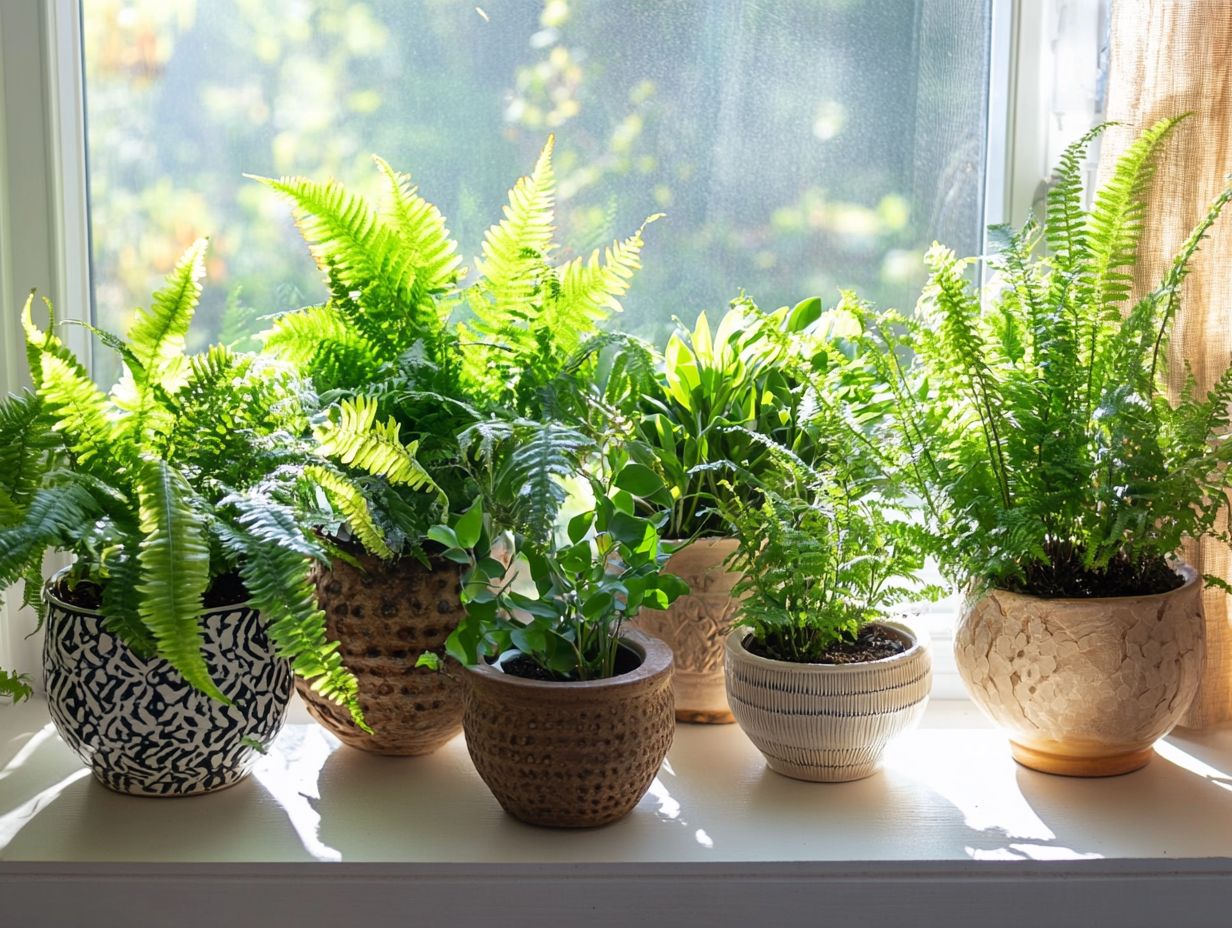
What are the best indoor ferns for beginners?
Some of the best indoor ferns for beginners include the Boston fern, the maidenhair fern, and the staghorn fern.
Are indoor ferns suitable for low-light environments?
Yes, there are many varieties of ferns that can thrive in low-light conditions. Some examples include the bird’s nest fern and the button fern.
Do indoor ferns require a lot of maintenance?
Not necessarily. While some ferns may require more attention, there are low-maintenance options such as the rabbit’s foot fern and the lace fern.
How often should indoor ferns be watered?
This will depend on the specific type of fern and its environment, but as a general rule, most ferns should be watered once a week. It’s important to check the soil moisture and adjust watering accordingly.
Can indoor ferns be grown in containers or hanging baskets?
Yes, many ferns can be grown in containers or hanging baskets, making them great options for adding greenery to small spaces. Just be sure to choose a container with good drainage and use a well-draining potting mix, which allows excess water to escape, preventing root rot.
Are indoor ferns safe for pets?
While ferns are generally safe for pets, it’s important to research the specific type of fern you are planning to bring into your home. Some ferns may be toxic to cats or dogs if ingested.
Ready to find the perfect fern for your space? Start exploring today!

